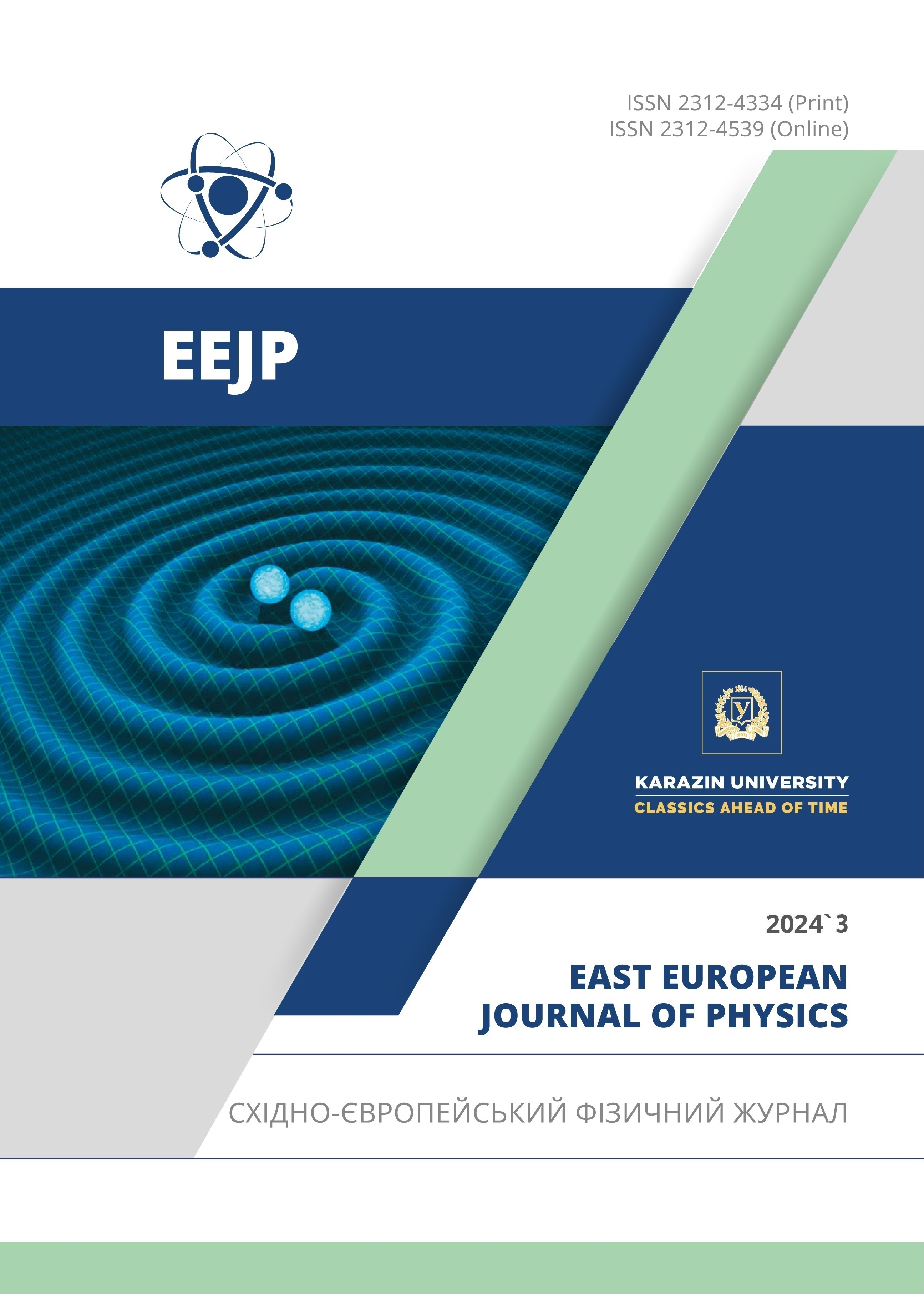Strengthen the Power Conversion Efficiency of Solar Cell Based RbGeI3: Numerical Approach
Abstract
The current study employs numerical simulations via the SCAPS-1D platform to investigate the performance of solar cells based on perovskite, with RbGeI3 utilized as an absorber material possessing a wide bandgap of 1.31 eV. Through systematic exploration of various parameters including temperature, layer thickness, doping, and defects, the study aims to enhance the efficiency of the solar cells, considering their sensitivity to temperature variations. Results demonstrate that the proposed configuration effectively extends the absorption spectrum into the near-infrared region, with the thickness of the RbGeI3 layer emerging as a critical factor influencing device performance. Analysis reveals that the series resistance peaks at 2 Ω·см2, while the shunt resistance achieves optimal output parameters of up to 103 Ω·см2. Moreover, optimization efforts yield a solar cell exhibiting a power conversion efficiency of 24.62%, fill factor of 82.8%, open circuit voltage of 0.99V, and short circuit current density of 33.20 mA/cm2 at a RbGeI3 thickness of 0.6 um. This comprehensive numerical investigation not only enhances understanding of the intricate factors influencing perovskite solar cells but also suggests promising avenues for future advancements in the field.
Downloads
References
L.C. Chen, C.H. Tien, Z.L. Tseng, and J.H. Ruan, “Enhanced efficiency of MAPbI3 perovskite solar cells with FAPbX3 perovskite quantum dots,” Nanomaterials, 9(1), 121 (2019). https://doi.org/10.3390/nano9010121
B. Saparov, et al., “Thin-film deposition and characterization of a Sn-deficient perovskite derivative Cs2SnI6,” Chem. Mater. 28, 2315–2322 (2016). https://doi.org/10.1021/acs.chemmater.6b00433
B. Lee, et al., “Air-stable molecular semiconducting iodosalts for solar cell applications: Cs2SnI6 as a hole conductor,” J. Am. Chem. Soc. 136, 15379–15385 (2014). https://doi.org/10.1021/ja508464w
Yousfi, A., and W. Feneniche. "Effect of Graded Double Perovskite for Boosting up the Photovoltaic Output Parameters of Solar Cell: A Numerical Modelling Using SCAPS-1D." Journal of Nano-and Electronic Physics 15.6 (2023). https://doi.org/10.21272/jnep.15(6).06002
B, Sagar, D, Jayan, A, Yousfi et al. "Novel double graded perovskite materials for performance increment of perovskite solar cell using extensive numerical analysis."Physica Scripta 98.9, 095507(2023). https://doi.org/10.1088/1402-4896/aceb97
M. Elbar, S. Tobbeche, S. Chala, O. Saidani, M.N. Kateb, and M.R. Serdouk, “Effect of Temperature on the Performance of CGS/CIGS Tandem Solar Cell,” J. Nano- Electron. Phys. 15(1) 01020 (2023). https://doi.org/10.21272/jnep.15(1).01020
A. Yousfi, O. Saidani, Z. Messai, R. Zouache, M. Meddah, and Y. Belgoumri, “Design and simulation of a triple absorber layer perovskite solar cell for high conversion efficiency,” East European Journal of Physics, 4, 137-146 (2023). https://doi.org/10.26565/2312-4334-2023-4-14
S. Shao, J. Liu, G. Portale, H.H. Fang, G.R. Blake, G.H. ten Brink, et al., “Highly reproducible Sn‐based hybrid perovskite solar cells with 9% efficiency,” Advanced Energy Materials, 8(4), 1702019 (2018). https://doi.org/10.1002/aenm.201702019
H. Bencherif, and M.K. Hossain, “Design and numerical investigation of efficient (FAPbI3)1–x(CsSnI3)x perovskite solar cell with optimized performances,” Sol. Energy, 248, 137–148 (2022). https://doi.org/10.1016/j.solener.2022.11.012
X. Qiu, et al., “From unstable CsSnI3toair-stable Cs2SnI6: A lead-free perovskite solar cell light absorber with bandgap of 1.48 eV and high absorption coefficient,” Sol. Energy Mater. Sol. Cells, 159, 227–234 (2017). https://doi.org/10.1016/j.solmat.2016.09.022
M.S. Uddin, M.A. Al Mashud, G.I. Toki, R. Pandey, M. Zulfiqar, O. Saidani, et al., “Lead‑free Ge‑based perovskite solar cell incorporating TiO2 and Cu2O charge transport layers harnessing over 25% efficiency,” J. Opt. (2023). https://doi.org/10.1007/s12596-023-01570-7
A. Miyata, et al., “Direct measurement of the exciton binding energy and effective masses for charge carriers in organic–inorganic tri-halide perovskites,” Nat. Phys. 11, 582–587 (2015). https://doi.org/10.1038/nphys3357
H. Bencherif, et al., “Performance enhancement of (FAPbI3)1–x(MAPbBr3)x perovskite solar cell with an optimized design,” Micro Nanostruct. 171, 207403 (2022). https://doi.org/10.1016/j.micrna.2022.207403
Y. Shao, et al., “Grain boundary dominated ion migration in polycrystalline organic–inorganic halide perovskite films,” Energy Environ. Sci. 9, 1752–1759 (2016). https://doi.org/10.1039/C6EE00413J
N. Rolston, et al., “Engineering stress in perovskite solar cells to improve stability,” Adv. Energy Mater. 8, 1802139 (2018). https://doi.org/10.1002/aenm.201802139
H.L. Zhu, J. Xiao, J. Mao, H. Zhang, Y. Zhao, and W.C.H. Choy, “Controllable crystallization of CH3NH3Sn0.25Pb0.75I3 perovskites for hysteresis-free solar cells with efficiency reaching 15.2%,” Adv. Funct. Mater. 27(11), 1605489 (2019). https://dx.doi.org/10.1002/adfm.201605469
M.K. Hossain, et al., “Influence of natural dye adsorption on the structural, morphological and optical properties of TiO2 Based photoanode of dye-sensitized solar cell,” Materials Science-Poland, 36, 93–101 (2017). https://doi.org/10.1515/msp-2017-0090
M.K. Hossain, et al., “A comparative study on the influence of pure anatase and Degussa-P25 TiO2 nanomaterials on the structural and optical properties of dye sensitized solar cell (DSSC) photoanode,” Optik, 171, 507–516 (2018). https://doi.org/10.1016/j.ijleo.2018.05.032
H.-S. Kim, et al., “Lead Iodide perovskite sensitized all-solid-state submicron thin film mesoscopic solar cell with efficiency exceeding 9%,” Sci. Rep. 2, 591 (2012). https://doi.org/10.1038/srep00591
M.F. Pervez, et al., “Influence of total absorbed dose of gamma radiation on optical bandgap and structural properties of Mg-doped zinc oxide,” Optik, 162, 140–150 (2018). https://doi.org/10.1016/j.ijleo.2018.02.063
M.M. Lee, J. Teuscher, T. Miyasaka, T.N. Murakami, and H.J. Snaith, “Efficient hybrid solar cells based on meso-superstructured organometal halide perovskites,” Science, 338, 643–647 (2012). https://doi.org/10.1126/science.1228604
M.N.H. Mia, et al., “Influence of Mg content on tailoring optical bandgap of Mg-doped ZnO thin film prepared by sol-gel method,” Results Phys. 7, 2683–2691 (2017). https://doi.org/10.1016/j.rinp.2017.07.047
R. Zouache, I. Bouchama, O. Saidani, L. Djedoui, and E. Zaidi, “Numerical study of high-efficiency CIGS solar cells by inserting a BSF µc-Si: H layer,” Journal of Computational Electronics, 21(6), 1386-1395 (2022). https://doi.org/10.1007/s10825-022-01942-5
A. Mei, et al., “A hole-conductor-free, fully printable mesoscopic perovskite solar cell with high stability,” Science, 345, 295 298 (2014). https://doi.org/10.1126/science.1254763
A. Baktash, O. Amiri, and A. Sasani, “Improve efficiency of perovskite solar cells by using Magnesium doped ZnO and TiO2 Compact layers,” Superlattices Microstruct. 93, 128–137 (2016). https://doi.org/10.1016/j.spmi.2016.01.026
L. Kavan, “Conduction band engineering in semiconducting oxides (TiO2, SnO2): Applications in perovskite photovoltaics and beyond,” Catal. Today, 328, 50–56 (2019). https://doi.org/10.1016/j.cattod.2018.10.065
O, SAIDANI, A, YOUSFI, et al. Numerical study of high performance lead free CsSnCl3 based perovskite solar cells. Journal of Optics, p. 1-19(2024). https://doi.org/10.1007/s12596-024-01817-x
X.-F. Diao, et al., “Study on the property of electron-transport layer in the doped formamidinium lead iodide perovskite based on DFT,” ACS Omega, 4, 20024–20035 (2019). https://doi.org/10.1021/acsomega.9b03015
M.F. Rahman, et al., “Concurrent investigation of antimony chalcogenide (Sb2Se3 and Sb2S3)-based solar cells with a potential WS2 electron transport layer,” Heliyon, 8, e12034 (2022). https://doi.org/10.1016/j.heliyon.2022.e12034
B. Gil, et al., “Recent progress in inorganic hole transport materials for efficient and stable perovskite solar cells,” Electron. Mater. Lett. 15, 505–524 (2019). https://doi.org/10.1007/s13391-019-00163-6
Y. Meng, P.P. Sunkari, M. Meilă, and H.W. Hillhouse, “Chemical Reaction Kinetics of the Decomposition of Low-Bandgap Tin–Lead Halide Perovskite Films and the Effect on the Ambipolar Diffusion Length,” ACS Energy Letters, 8(4), 1688-1696 (2023). https://doi.org/10.1021/acsenergylett.2c02733
S. Rafique, S.M. Abdullah, M.M. Shahid, M.O. Ansari, and K. Sulaiman, “Significantly improved photovoltaic performance inpolymer bulk heterojunction solar cells with graphene oxide/PEDOT:PSS double decked hole transport layer,” Sci. Rep. 7, 39555 (2017). https://doi.org/10.1038/srep39555
S. Wang, et al., “Role of 4- tert -butylpyridine as a hole transport layer morphological controller in perovskite solar cells,” Nano Lett. 16, 5594–5600 (2016). https://doi.org/10.1021/acs.nanolett.6b02158
C. Liu, et al., “Highly stable and efficient perovskite solar cells with 22.0% efficiency based on inorganic-organic dopant-free double hole transporting layers,” Adv. Funct. Mater. 30, 1908462 (2020). https://doi.org/10.1002/adfm.201908462
D. Shin, et al., “BaCu2Sn(S,Se)4: Earth-abundant chalcogenides for thin-film photovoltaics,” Chem. Mater. 28, 4771–4780 (2016). https://doi.org/10.1021/acs.chemmater.6b01832
R. Chakraborty, et al., “Colloidal synthesis, optical properties, and hole transport layer applications of Cu2BaSnS4 (CBTS) nanocrystals,” ACS Appl. Energy Mater. 2, 3049–3055 (2019). https://doi.org/10.1021/acsaem.9b00473
T. Das, G. Di Liberto, and G. Pacchioni, “Density functional theory estimate of halide perovskite band gap: When spin orbit coupling helps,” J. Phys. Chem. C, 126, 2184–2198 (2022). https://doi.org/10.1021/acs.jpcc.1c09594
M.B. Bechir, and M.H. Dhaou, “Study of charge transfer mechanism and dielectric relaxation of all-inorganic perovskite CsSnCl3,” RSC Adv. 11, 21767–21780 (2021). https://doi.org/10.1039/D1RA02457D
M.S. Ali, S. Das, Y.F. Abed, and M.A. Basith, “Lead-free CsSnCl3 perovskite nanocrystals: Rapid synthesis, experimental characterization and DFT simulations,” Phys. Chem. Chem. Phys. 23, 22184–22198 (2021). https://doi.org/10.1039/D1CP02666F
J. Islam, and A.K.M.A. Hossain, “Semiconducting to metallic transition with outstanding optoelectronic properties of CsSnCl3 perovskite under pressure,” Sci. Rep. 10, 14391 (2020). https://doi.org/10.1038/s41598-020-71223-3
J. Islam, and A.K.M.A. Hossain, “Narrowing band gap and enhanced visible-light absorption of metal-doped non-toxic CsSnCl3 metal halides for potential optoelectronic applications,” RSC Adv. 10, 7817–7827 (2020). https://doi.org/10.1039/C9RA10407K
M.I. Kholil, M.T.H. Bhuiyan, M.A. Rahman, M.S. Ali, and M. Aftabuzzaman, “Effects of Fe doping on the visible light absorption and bandgap tuning of lead-free (CsSnCl3) and lead halide (CsPbCl3) perovskites for optoelectronic applications,” AIP Adv. 11, 035229 (2021). https://doi.org/10.1063/5.0042847
M.I. Kholil, and M.T. H. Bhuiyan, “Effects of Cr- and Mn-alloying on the band gap tuning, and optical and electronic properties of lead-free CsSnBr3 perovskites for optoelectronic applications,” RSC Adv. 10, 43660–43669 (2020). https://doi.org/10.1039/D0RA09270C
O. Saidani, Y. Abderrahim, M. Zitouni, G.S. Sahoo, R. Zouache, M.R. Mohammad, et al., “Numerical study of high‑performance lead‑free CsSnCl3‑based perovskite solar cells,” Journal of Optics, 1-19 (2024). https://doi.org/10.1007/s12596-024-01817-x
J. Ur Rehman, et al., « First-principles calculations to investigate structural, electronics, optical and elastic properties of Sn-based inorganic Halide-perovskites CsSnX3(X = I, Br, Cl) for solar cell applications,” Comput. Theor. Chem. 1209, 113624 (2022). https://doi.org/10.1016/j.comptc.2022.113624
M.H. Ali, et al., “Numerical analysis of FeSi2 based solar cell with PEDOT:PSS hole transport layer,” Mater. Today Commun. 34, 105387 (2023). https://doi.org/10.1016/j.mtcomm.2023.105387
Copyright (c) 2024 Lazhar Loumachi, Abderrahim Yousfi, Okba Saidani, Abdullah Saad Alsubaie, Oussama Abed, Samir Amiri, Girija Shankar Sahoo, Md. Rasidul Islam

This work is licensed under a Creative Commons Attribution 4.0 International License.
Authors who publish with this journal agree to the following terms:
- Authors retain copyright and grant the journal right of first publication with the work simultaneously licensed under a Creative Commons Attribution License that allows others to share the work with an acknowledgment of the work's authorship and initial publication in this journal.
- Authors are able to enter into separate, additional contractual arrangements for the non-exclusive distribution of the journal's published version of the work (e.g., post it to an institutional repository or publish it in a book), with an acknowledgment of its initial publication in this journal.
- Authors are permitted and encouraged to post their work online (e.g., in institutional repositories or on their website) prior to and during the submission process, as it can lead to productive exchanges, as well as earlier and greater citation of published work (See The Effect of Open Access).








